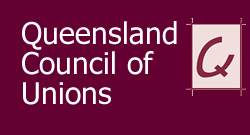Queensland Council of Unions
 |
|
| Full name | Queensland Council of Unions |
|---|---|
| Founded | 1922 |
| Members | 370,000 from affiliated unions |
| Affiliation | ACTU |
| Key people | Rohan Webb, President Ros McLennan, General Secretary Beth Mohle and Owen Doogan, Senior Vice Presidents |
| Office location | 16 Peel Street, South Brisbane, Queensland |
| Country | Australia |
| Website | www.qcu.asn.au |
The Queensland Council of Unions (QCU) is a representative, peak body of Queensland trade union organisations, also known as a labour council, in the State of Queensland, Australia. As of 2014 there are 35 affiliated unions and 13 regional branches. The QCU represents unions covering more than 370,000 Queensland workers. The QCU is the state branch of the Australian Council of Trade Unions (ACTU). Its offices are located in the suburb of South Brisbane, Queensland.
The history of the QCU is intertwined with the history of the Australian Labor Party (ALP) and the Australian labour movement generally. The QCU was formed in 1885 but in 1889 disbanded and transferred all its roles and responsibilities to a newly formed peak body the Australian Labor Federation (ALF) (which despite its name was restricted to Queensland). In 1902 the QCU reformed but again, in 1911, all its delegates moved to the ALF. In 1914 the ALF itself dissolved, its affiliates having been swallowed by the growing Australian Workers Union (AWU). At this time the roles of the QCU were shared by a number of labour organisations, including the Brisbane Industrial Council, the Eight Hour Union and the Brisbane Trades Hall Board. At the end of World War One in 1918 Queensland unions regrouped but it was another four years before 46 unions reformed the Queensland Trades and Labour Council, now known as the QCU.
As a peak body for the Queensland trade unions the objective of the QCU is to achieve industrial, social and political justice for Queensland workers. Management structure of the QCU is made up of a committee of management and an executive of 35 representatives, one from each of the affiliated unions.
The origins of the organisation lie in the rapid rise of the Australian labour movement in the 1880s. Due to a mining and pastoral boom in the regions outside South East Queensland there was an influx of large numbers of immigrant workers, while in Brisbane and South East Queensland a number of small craft unions were established. On 18 August 1885 a meeting of union secretaries decided to form the Trades and Labour Council, which came into being on 1 September 1885. The next year, 1886, the new labour organisation was sanctioned by the Liberal government of the day (led by the then moderate liberal Samuel Walker Griffith) which passed the Queensland Trade Union Act, legitimising trade unionism in the colony.
...
Wikipedia
